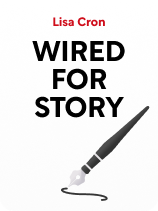

This article is an excerpt from the Shortform book guide to "Wired for Story" by Lisa Cron. Shortform has the world's best summaries and analyses of books you should be reading.
Like this article? Sign up for a free trial here.
How’s a story’s plot different from what your story is about? How can understanding how the brain works help you create a compelling plot?
Lisa Cron explains the formula that the human brain expects to encounter in a story. Then, she shows how you as a writer can employ that formula. She provides tips on how to develop a plot—exploring elements such as conflict, cause and effect, hooking the reader, suspense and reveals, and pacing.
Continue reading to learn how to develop a plot that satisfies the expectations of your readers.
How to Develop a Plot
Before diving into her advice on how to develop a plot, Cron clarifies what the plot actually is. She explains that the plot refers to the actual events that occur in the story. This is often mistaken for what the story’s about, but what the story’s truly about is how the protagonist changes as a result of the story’s events. Plot is the external events of the narrative, while the story is about the protagonist’s internal reactions.
Conflict
Plot consists of the many conflicts that create obstacles to your protagonist achieving their goal. To subject your protagonist to these seemingly impossible obstacles, you have to establish and escalate conflict in your story.
Stories are about change, and conflict is what drives change. According to Cron, our brains are programmed to resist conflict. We evolved to cooperate for survival, so conflict with others poses a risk to our survival—and in fact, according to an MRI study, conflict causes the brain areas associated with physical pain to light up.
Our brains also resist change, whether it’s a good or bad change. We evolved to seek to maintain a state of secure equilibrium to ensure our well-being—if we’ve found a routine that keeps us safe, making a change to that routine creates a potential risk to our safety, which makes us fearful.
However, because things constantly change in life despite our wish for them not to, stories must also be about conflict and change. Cron writes that there are many potential sources of conflict in a story: Any way you can find to pit two forces against each other in a way that impacts the protagonist emotionally and interferes with their goal is a potential conflict and impetus for change. Some of these include the conflict between the protagonist’s belief and reality, the conflict between what the protagonist wants and what others expect of them, the conflict between the protagonist’s internal and external goals, and the classic conflict between the protagonist and the antagonist.
Cause and Effect
Showing how conflict leads to change also requires us as writers to convey a clear pattern of cause and effect. According to Cron, we have a neurological need to understand the reasons behind everything, which means our stories need to have a clear cause-and-effect structure on both the external plot level and the internal level of the protagonist’s choices. Things can’t just happen at random—rather, every action must have a reaction which then affects the next decisions the characters make. This establishes the logic of your story, which the brain needs to maintain interest.
Cron points out that the maxim “Show, don’t tell” is commonly misunderstood to mean that we should avoid explicitly stating something—like the emotion a character’s feeling—and instead show them feeling it, by expressing it physically (through crying, yelling, smiling, and so on). However, she argues that what it really means is we need to show the cause-and-effect process that leads to that feeling. It’s not enough to say your character is angry. Rather, we need to see the event that made them angry, and we need to understand the internal thought process that caused them to react the way they did to the story’s events.
According to Cron, this cause-and-effect structure must be consistent throughout your story, which means that each scene will logically lead into the next one. The previous scene will catalyze the next scene, and the effects of the characters’ choices in the previous scene will determine the choices they make in the next scene. This also means your protagonist needs to change from scene to scene. They should feel differently at the end of the scene than they did at the beginning. By connecting all the scenes in your story in this way, you’ll create a cohesive, logical narrative that helps the reader understand the reason behind everything and satisfies their neurological need to simulate an experience they’ve never had.
Hooking the Reader
As soon as the reader begins your story, they start looking for the answers to three major questions: 1) Who’s the story about? 2) What’s the story about? 3) What’s at stake here? If the answer to any of these three questions is missing, it doesn’t matter how beautiful your prose is; the reader will not be interested in your story. However, says Cron, if you answer them quickly—on the first page, or even in the very first sentence—you can take your time presenting the rest of the details because your reader knows what to anticipate.
The answers to these questions give the reader context for how to understand everything they’re about to read, which, according to neuroscientific research, is how they determine meaning, or the “why” behind every piece of information. Answering these “why” questions is critical to do because humans have a natural curiosity about why any given piece of information is significant or useful to us, and having that curiosity sated is what keeps us engaged with what we’re reading.
For instance, we don’t just want to know that the protagonist is getting a divorce; we want to know the specific reasons why they’re getting a divorce so we can understand how the divorce will impact the protagonist and how it might affect what they’re going to do next.
Suspense and Reveals
According to Cron, the push and pull between two conflicting forces allows the writer to build suspense by withholding information that the reader wants to know. Suspense is what keeps the reader turning the page because of our cognitive need to know what happens next.
While the big “reveal” of withheld information can be extremely powerful, it only works if everything up until that reveal is clear and logical enough for the reader to understand. The writer must give hints about the reveal in advance, so the reader has a sense that something is missing, but the absence of that missing piece can’t obscure the story.
These hints must also be specific enough that the reader can guess what the reveal might be, even if their guesses prove to be completely wrong. It’s not interesting enough to know that the writer is keeping something secret. We have to have some sense of what they’re keeping secret.
For instance, a mystery writer might plant hints throughout the plot that point to the identity of the murderer. The reader will know the writer is keeping the murderer’s identity a secret to be revealed later. Even if they incorrectly guess who it is, they’ll still be able to understand the logical sequence of events that led the person to kill because the writer’s withholding of the murderer’s identity won’t obscure the rest of the story.
A reveal can’t be the piece that gives the plot meaning, but it can—and should—change the meaning in retrospect as readers look back through the story and understand what new light the reveal sheds on what’s happened.
Foreshadowing
This leads into another important idea from neuroscience: Part of the way we make sense of what’s happening to us is to call on memories from the past that help us interpret what’s going on in the present. According to Cron, you need to provide your reader with such memories so major reveals in the story will make sense.
To do this, you can use foreshadowing, which is when you give the reader hints about a change that’s going to happen later in the story. When you foreshadow, you essentially create a memory for the reader to recall later, and that memory helps them make sense of eventual character or plot changes. Foreshadowing importantly also lets you justify a choice by your protagonist that seems out of character. In fact, any out-of-character choice your protagonist makes must be warned of in advance.
For example, if you establish in chapter one that your protagonist has a deathly fear of flying, but later they need to get on a plane to save the world, you have to include information in those intervening chapters that justifies this choice, such as describing how the protagonist is taking steps to overcome their phobia.
Pacing and Timing
Cognitively, explains Cron, readers can only handle so much conflict at once. It’s important to present your story in a way that gives the reader a break after moments of extreme conflict so they can process what’s happened and try to understand how it fits into the larger story. Narrative devices such as subplots and flashbacks can help you provide readers with this break so they don’t become overwhelmed by constant conflict.
Subplots
Subplots are secondary stories that add to the overall story, explains Cron. They can give the reader some distance from the major conflict and allow them to process what’s happened. But to be effective, they must have an impact on the main story and the protagonist, either internally or externally.
They can also help flesh out other characters whose plots can provide insight into the main storyline. Writers can use subplots to mirror the main plot, showing an alternate way that the main storyline could play out, usually taking an opposite path from the one the main story takes.
In any case, as with everything else in your story, all the information in a subplot must be something the reader needs to know to understand the main plot and its impact on the protagonist.
Flashbacks
According to Cron, flashbacks also provide an opportunity to give the reader a break from the main conflict while supplying important information. They pull the reader out of the immediate story and into a different setting (often a subplot)—because of this, they should only be used when they’re absolutely essential because otherwise, the reader will feel like they’ve been yanked out of the story they were enjoying for one they don’t have any investment in.
Flashbacks should be placed only in spots where they provide context that’s necessary for understanding what happens next in the main story, and the reader should be able to tell right away what the purpose of the flashback is—they should be able to understand why they need this particular information right now.

———End of Preview———
Like what you just read? Read the rest of the world's best book summary and analysis of Lisa Cron's "Wired for Story" at Shortform.
Here's what you'll find in our full Wired for Story summary:
- How humans have a neurological need for stories
- The formula that the human brain expects to encounter in a story
- How to build a protagonist that engages your reader






